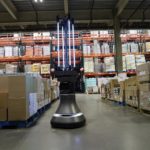 The return to work after lockdown measures is a hugely complex affair, with employers having to deal with various regulations alongside the concerns of employees, suppliers and customers alike. Given the unusual circumstances placed upon them, it’s perhaps no surprise that technology is playing a major part in the re-opening.
The return to work after lockdown measures is a hugely complex affair, with employers having to deal with various regulations alongside the concerns of employees, suppliers and customers alike. Given the unusual circumstances placed upon them, it’s perhaps no surprise that technology is playing a major part in the re-opening.
A good example comes from the Computer Science and Artificial Intelligence Laboratory (CSAIL) at MIT, who have developed a robot to try and ensure spaces are kept as clean as possible.
The researchers posit that in this most perilous of times, it’s vital that we keep surfaces clean to prevent the transmission of any droplets that may contain the virus. They argue that while chemical cleaning products are effective at cleaning such surfaces, it’s a highly labor intensive task to ensure they are cleaned repeatedly, especially in larger facilities. The cleaning process itself places workers at risk of catching the virus.
Keeping it clean
The MIT team, in collaboration with the Greater Boston Food Bank and Ava Robotics, developed a robotic system to disinfect surfaces using a UVC light that’s built into the base of a mobile robot. In initial tests, the team believe the results have been sufficiently impressive to suggest it could be a useful solution for a wide range of work environments, ranging from factories to supermarkets.
The system, which can operate without supervision, utilizes short-wavelength ultraviolet light to kill microorganisms via a process known as “ultraviolet germicidal irradiation”. The robot begins by mapping the space it will be working in, and then navigates between particular waypoints. During testing, the team measured the amount of UVC light being emitted with a UVC dosimeter to ensure safe levels were used.
During tests at the food bank, the robot was able to cover around 4,000 square feet of the warehouse in around 30 minutes, with the team claiming that roughly 90% of the coronaviruses on surfaces would be neutralized during this time.
The use of ultraviolet as a disinfectant is commonly used in hospitals, with startups such as Vital Vio pioneering the use of ultraviolet lights to disinfect hospital settings. While it’s most effective in direct line of sight, it can also get into hard to reach spaces because the light bounces off of surfaces.
Gradual progression
The team began by teleoperating the robot so that it could learn its way around the warehouseee. After a teaching process, it was then able to automatically navigate to particular waypoints on the map, such as the loading dock, followed by the shipping floor, before returning to base.
“As we drive the robot around the food bank, we are also researching new control policies that will allow the robot to adapt to changes in the environment and ensure all areas receive the proper estimated dosage,” the team explains. “We are focused on remote operation to minimize human supervision, and therefore, the additional risk of spreading Covid-19, while running our system.”
The next step for the project is to improve the onboard sensors so that they’re better able to adapt to changes in their environment, while also adjusting the speed of the robot to ensure the desired dosage of UV lighting is applied to surfaces.
This is important in environments that are rapidly changing, such as in the shipping area of the Food Bank’s warehouse, where the environment changes slightly each night. For instance, it wouldn’t be possible for the robot to know in advance which staging aisle was in use, or how full the aisles might be, so it’s important that the robot can distinguish between occupied and unoccupied aisles.
Uncertain terrain
Obviously with each work environment likely to be different, there are challenges involved in ensuring that the robots are capable of operating across a range of terrains and environments. Given the advances made by the technology since Amazon bought Kiva in 2012, this shouldn’t be a major hurdle.
“Thanks to advance vision systems and locomotion mechanisms, different forms of robots, ranging from human-like bipedal and animal-like quadrupedal, can effectively avoid obstacles and find the best routes almost without human control,” Sangseok You, Professor of Information Systems at HEC Paris says. “Robots that are deployed to warehouses and supermarkets mostly follow a pre-determined course that uses markers and colored lines, for navigation.”
The ability for robots to learn their environment is enhanced by their ability not only to learn very quickly, but to easily share that knowledge with other robots, thus creating a kind of “hive mind”.
“Robots equipped with machine learning capabilities can learn and adapt to new environments using sensors, motors, and reinforcement mechanisms,” You continues. “Some robots even share knowledge acquired from an environment with other robots”.
For the EIT team, they plan to conduct further work on the robot to extend its capabilities in partnership with GBFB, with an eventual intention to make the robot capable of dynamically changing its actions depending on estimated UVC dosages and working effectively among a team of UVC robots in a single facility.
“We are excited to see the UVC disinfecting robot support our community in this time of need,” says CSAIL director and project lead Daniela Rus. “The insights we received from the work at GBFB has highlighted several algorithmic challenges. We plan to tackle these in order to extend the scope of autonomous UV disinfection in complex spaces, including dorms, schools, airplanes, and grocery stores.”